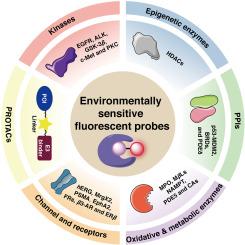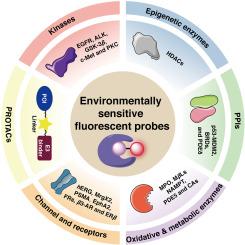Environmentally sensitive fluorescent probes for the visualization of selective proteins: Recent progress and biomedical applications
IF 5.9
2区 医学
Q1 CHEMISTRY, MEDICINAL
引用次数: 0
Abstract
Environmentally sensitive fluorescent probes represent an emerging class of chemical tools that enable the visualization of selective proteins. These probes typically consist of a target-selective ligand, an appropriate linker and a responsive fluorophore that generally undergoes turn-on emission when its local microenvironments such as polarity and viscosity changes. In contrast to traditional always-on dyes, this modular design affords high signal-to-noise ratios and wash-free imaging. Recent advances have expanded the application of such probes from kinases and histone deacetylases to regulators of protein-protein interaction, metabolic enzymes, channels and receptors. Key strategies for the design of these probes include the use of environmentally sensitive fluorophores to enhance fluorescence contrast. A couple of turn-on probes have been applied to assess the activity of proteolysis-targeting chimeras (PROTACs), while fluorescent PROTACs allow direct tracking of target degradation in living systems. This review summarizes recent advances (2020–2025) in strategies for design, mechanisms of activation, and biological applications, and outlines future directions including the development of NIR-II fluorophores, AI-assisted discovery and in vivo translation.


环境敏感荧光探针用于选择性蛋白质的可视化:最新进展和生物医学应用
环境敏感的荧光探针代表了一类新兴的化学工具,使选择性蛋白质的可视化。这些探针通常由一个目标选择性配体、一个合适的连接体和一个响应性荧光团组成,当其局部微环境(如极性和粘度)发生变化时,荧光团通常会发生开启发射。与传统的常亮染料相比,这种模块化设计提供了高信噪比和免水洗成像。近年来的进展已将这类探针的应用范围从激酶和组蛋白去乙酰化酶扩展到蛋白质-蛋白质相互作用的调节因子、代谢酶、通道和受体。设计这些探针的关键策略包括使用环境敏感的荧光团来增强荧光对比度。一些开启探针已被用于评估蛋白水解靶向嵌合体(PROTACs)的活性,而荧光PROTACs允许直接跟踪生命系统中的目标降解。本文综述了NIR-II在设计策略、激活机制和生物应用方面的最新进展(2020-2025),并概述了未来的发展方向,包括NIR-II荧光团的开发、人工智能辅助发现和体内翻译。
本文章由计算机程序翻译,如有差异,请以英文原文为准。
求助全文
约1分钟内获得全文
求助全文
来源期刊
CiteScore
11.70
自引率
9.00%
发文量
863
审稿时长
29 days
期刊介绍:
The European Journal of Medicinal Chemistry is a global journal that publishes studies on all aspects of medicinal chemistry. It provides a medium for publication of original papers and also welcomes critical review papers.
A typical paper would report on the organic synthesis, characterization and pharmacological evaluation of compounds. Other topics of interest are drug design, QSAR, molecular modeling, drug-receptor interactions, molecular aspects of drug metabolism, prodrug synthesis and drug targeting. The journal expects manuscripts to present the rational for a study, provide insight into the design of compounds or understanding of mechanism, or clarify the targets.

 求助内容:
求助内容: 应助结果提醒方式:
应助结果提醒方式:


